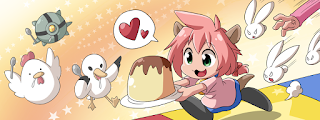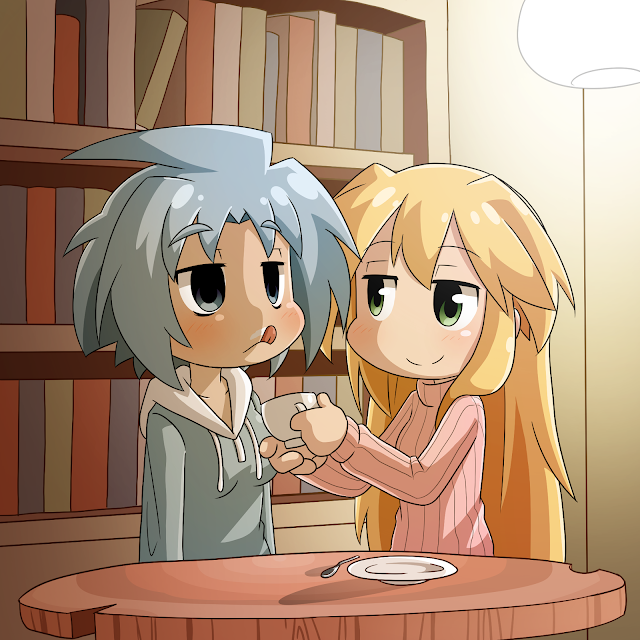[Admin] Analysis for Party Time
Original story here.
=====================================
=====================================
Party
Time was a piece I had great difficulty with, and there are a few
reasons why. The first reason was a small amount of burnout; at the
time that I started Party Time, I had just written and released about
10,000 words in the course of a week, which is a bit of an ask, and I
was in need of some time to recharge my batteries a little. The
second reason was that the art I was being prompted by was relatively
one-dimensional: it depicts a party being ruined in a comedic way,
and unlike Lost Child, the previous Community Card Pack prompt, I
couldn’t find any way to really spin it into a new direction
without running afoul of problem number three: that the prompt called
for quite a lot of characters being involved, and quite a few of them
were ones I was dreading working with.
It’s
difficulty to gauge the impact of burnout on a finished piece,
because the usual consequence of burnout is that the piece just
doesn’t get finished. You realise that you’re grinding your face
against a mountain and put the idea aside for later; whether it
eventually comes to fruition or not, it won’t be in the form you
had envisioned when you first made the attempt. In a sense, that
process did actually
happen, multiple times; Party Time is in fact one of the stories with
both the most drafts and the longest drafts, out of anything I’ve
written. The good thing is that, like any writer, I’m a firm
believer in recycling; Krila’s thoughts on cakes were rescued from
a previous version, where Kai played a part in the story. The bad
thing it was excessive drafting saps the willpower and leads to even
more burnout.
I
think the primary thing the story lost in the process of finally
grabbing that last, definitive draft was language. When I write
comedy stories, my focus is split between the procession of funny
events, the humour of the characters, and on making the words turn
tricks for my amusement. A
comedy story in which I’m having fun is usually replete with
‘Vulp-isms’, little
sections where I use language in interesting or unexpected ways. You
can see examples of this in a few places, but the QPverse comedy
stories in particular tend to have a fair few of them. While not
unique to me, they’re something that I would consider a hallmark of
my style. Sadly, they’re often the first thing to go when the story
becomes a grind. While I kept in as much as I could, I was a little
disappointed in how often I found myself relying on situational
comedy. As funny as I find
the idea of Sweet Breaker being a pro-wrestler, that segment is one
of my least favourite in the piece because it’s a weak stretch
linguistically.
How
did I try to address the burn out problem, and how would I choose to
address it in the future? Well, an obvious but unhelpful answer is
‘take a break’. In my experience, that leads to the break
becoming a hiatus, and the hiatus stretching on ever longer until
you’re sad and intimidated by your own craft. Not fun. What I’ve
done traditionally is look over old comments or reviews on my work
for motivation, and to remind myself that I’m not awful at what I
do. (One of the main problems with burn out is that it makes
everything feel harder, which makes you feel like you’re worse,
which knocks your self esteem, which means you proceed more timidly
so everything feels harder…) That’s worked in previous fandoms,
but the OJ fanbase isn’t very big, and my readership isn’t even a
large part of that – there isn’t much feedback to go over. What I
did instead is work on something else that I would hopefully enjoy
more as a project, which is why Speaking in Tongues came out before
Party Time even though Party
Time was started long before. In
the future, I might try switching up my writing style to something
that’s novel to me, or else just completely backing away and
approaching the prompt from another angle – a tactic that has
worked in the past, but wasn’t feasible for this story.
The
second problem was that there wasn’t a great deal of scope in what
I could make out of the prompt. The art is a specific set of
characters in a specific situation, and if I wanted to use it as a
prompt that gave me a limited amount of wriggle room. In particular,
the premise of a party locked me into using a lot
of characters; I tend to prefer to focus on one or two. There
are places in the story where this becomes apparent – characters
like Syura, Sweet Breaker, Poppo and Marc are present, but there just
isn’t enough space to give them large roles in the narrative, so
they feel tacked on.
There
was also the problem of a lot of new
characters being used. Characters in Orange Juice tend to be fairly
simple and shallow; they have one large character trait, one role in
the story, and then it’s on to the next character. That’s fine
for a shooting game, but it makes writing stories difficult. Unlike a
fan artist, a fan fiction writer is expected (or at least encouraged)
to keep the characters in character; if they’re not, it’s seen as
a lack of skill. Usually, I deal with shallow characters by starting
at their canon personality, and then adding small details over the
course of a few stories until I’ve arrived at a more cohesive,
stylised interpretation of them that still feels in line with the
original. That makes new characters a big challenge, since I have to
start from square one, and introducing multiple new characters a huge
challenge, since I have to give each of them enough time and space to
start growing.
If
I had gone with the prompt as given, I would have had to deal with
Fernet, Kai and Poppo as brand new characters – all of whom I would
consider particularly challenging to develop. Fernet hails from
Flying Red Barrel, a game that’s flown largely under the radar and
has no Steam release; her characterisations in 100% Orange Juice and
200% Mixed Juice are suspect as a result of the premise of the
stories in those games. Because of that, I have very little idea of
‘canon’ Fernet; she’s rich, and that’s about it. Kai and
Poppo at least have some kind of accessible canon since their 100%
Orange Juice characterisations are
applicable, but Kai lacks personality (without taking the voice pack
into account, which did a great job in fleshing him out a bit) and
Poppo has a fifty-fifty spread of being an irritating Poke-speak
nonsense character and then actually existing.
Kai
and Poppo did appear in one of the drafts, but didn’t work out.
Rather than deal with their nonsense, I decided to try an alternative
route and work with Marc, Fernet and Sweebo. Sweet Breaker I
eventually just used for a cracky joke, but with Marc I tried to
establish a sunny disposition, and Fernet got the lion’s share of
characterising tangents. Poppo was relegated to a joke as well. I
also tried to split the story up into various scenes, where
characters I had
worked with before – QP, Syura and Krila – could help to carry
some of the narrative.
The
issue of too many characters still remained, however, and prevented
certain choices I might have made. For
one, it meant I couldn’t pivot on the prompt and try something
serious with it. A party that gets ruined could have been a serious
source of angst for Fernet, and given me room to explore her
personality… but there just wasn’t space when I had to have so
many characters running around, and a party without people is not a
party at all. A crowded
narrative either becomes very long or very chaotic, and of the two
chaos was probably my better option.
The
best way I could have dealt with all this is probably just adjusting
the timing on writing the story. If, for example, I had written
Flowers and the Sky before starting Party Time, I would have felt
much more comfortable about Marc as a character, and perhaps worked
the narrative to include more interactions between her and Fernet.
Or, I could have written a short preliminary story with Fernet as a
main character to give me time to develop her a little. However, it’s
sometimes hard to predict what you’ll want to write in advance, and
I was trying to follow a schedule of one community card art piece to
one normal story at the time. As
the issue of having too many characters, there wasn’t really a way
I could have written around that with the prompt.
Those
are the main problems I felt I faced, and how I either tackled them
or should have tackled them. As
for things I liked about the story… With a little distance, I’m
able to see that there were definitely parts where I made the
language dance, which I’m proud of. The Sweet Breaker section has
something of a drought, but the Sweet Breaker section is also one of
the most zany and outrageous parts to begin with; although it would
probably be better with some accompanying flair, I like it well
enough on its own. The sketch
of Marc’s character, however brief, planted the seeds for her
further characterisation in Flowers and the Sky, which is a piece I
feel quietly proud of – it unfolded almost effortlessly, and
probably wouldn’t have existed if I hadn’t taken a plunge on Marc
beforehand. I also laid some
decent groundwork for Fernet and her character quirks, so it was a
developmental kind of piece.
Overall,
although I think Party Time is not one of my favourite pieces, it was
useful practice and definitely has some amount of charm to it; it was
worth writing, and doesn’t
have the outright clumsiness of my worst work. If nothing else, it
shows that I can stick with a story even when it’s proving to be a
pain in the rear, which is a valid skill in and of itself.



Bravo, good sir! Your tenacity and diligence in dealing with and sticking to a difficult task is genuinely inspiring.
ReplyDelete